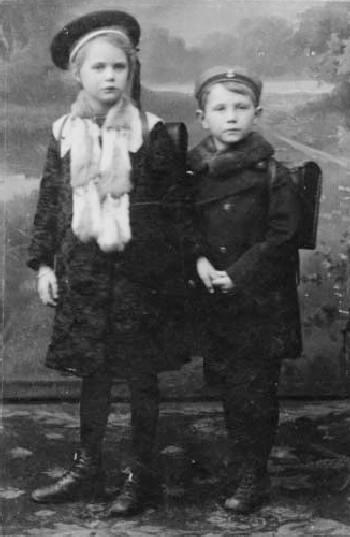
German Schoolwear: Coats

Figure 1.--Here we see an unidentifiefd German girl and her brother in their winter coats. You can tell this is how they went to school because they are wearing their school satchells. Notice the coats are shorter than often seen in the 19th century. The girl has a sailor cap and fur (rabbit?) stole. The boy wears an unusual cap, I think it is an Army-style cap. What looks like a pea jacket has a fur collar. Both have black long stockings to help keep them warm. The cabinent card is undated. It looks to have been taken about 1910. The studio was Sampson & Comp. in Remscheid. Photographs can be very revealing about relationships, even studio portraits. Notice how the girl is holding her little brother's hand. We would guess these two were very close.
|
|
Winters can be quite cold in Germany, not as cold as in Scadanavia and Russia, but colder than in England and France and especially southern Europe. England is located to the north, but benefits froin the Gulf Stream. Germany can get quite a bit of snow. Thus children needed a variety of jackets and coats to keep warm on the way to school during the wiunter winter. Light jackets and sweaters might be enough in the Spring and Fall, but children needed a heavy coat to go to school in the winter. We notice many different styles. Overcoasts seem fairly common in the 19th century. Here there seems to have been a social classs factor. Some coat styles might be worn by both boys and girls while others were gender specic garments. German schools did not require uniforms. Generally we know that the coats here were worn to school because the children were photographed with their school satchells. These were not coats specifically designed for school, but the children's regular clothes worn to school. A lot of jackets had navy styling and seemed to have been done in dark colors, often blue. We notice both long overcoats as well as shorter cut jsackets. Navy pea jackets seem to have been a popular style. Colors were geneally muted, although the black and white photograpohy of the day provides few insughts. After World War II when we begin to see more brightly colored coats. We also no longer see boys commonly wearing overcoasts, but rather heavy jackets.
Climate
Winters can be quite cold in Germany, not as cold as in Scadanavia and Russia, but colder than in England and France and especially southern Europe. England is located to the north, but benefits froin the Gulf Stream. Germany can get quite a bit of snow. Thus children needed a variety of jackets and coats to keep warm on the way to school during the winter. Light jackets and sweaters might be enough in the Spring and Fall, but children needed a heavy coat to go to school in the winter. The cold weather is why olter garments likr long stockings were so common in Germany.
We have only limited infirmation og German school coat at this time. We know nothing about the early-19th century. With the development of photography during the md-19th century we begin to see examples of the coats boys wore to school. We see some coats with fur. Even more common was fur trim and fur hasts. We see a lot of children in the late-19h century, at least children in coomfortable circunstaces wearing long overcoats. We note both single- and double-breased styling. Most boys' coats are dark colors in the 19th century. Some children, mosly gurls, wear light-colored coats. We still see long coats in the early-20th century, but gradually shorter-cut jackets become more common, for both boys and girls. After World War I, fur is used less on coats. After Workld War II we also no longer see boys commonly wearing overcoasts, but rather heavy jackets. Colorful ski jackets become popular in the 1970s.
Styles
We notice many different styles. Overcoasts seem fairly common in the 19th century.
A lot of jackets had navy styling. We notice both long overcoats as well as shorter cut jsackets. Navy pea jackets seem to have been a popular style.
Social Class
Coats were an expemnsive item. They often cost more thsan shoes. Thus sicial class frequently affected the coats boys wore. Long overcoats were nost likely to be worn by children from well-to-do families.
Gender
Some coat styles might be worn by both boys and girls while others were gender specic garments. There were also color differences. Girls coukld wear dark colors like the boys, but light colors were less common for boys.
Uniforms
German schools did not require uniforms. Generally we know that the coats here were worn to school because the children were photographed with their school satchells. These were not coats specifically designed for school, but the children's regular clothes worn to school.
Colors
We notice a lot of coats done in dark colors, often blue. Colors were generally muted, although the black and white photograpohy of the day provides few insights. We also notice grey and brown coats. Light cors were less common. After World War II when we begin to see more brightly colored coats.
HBC

Related Chronolgy Pages in the Boys' Historical Web Site
[Main Chronology Page]
[The 1880s]
[The 1930s]
[The 1940s]
[The 1950s]
[The 1960s]
[The 1970s]
[The 1980s]
Related Style Pages in the Boys' Historical Web Site
[Main school uniform page]
[Main country page]
[Long pants suits]
[Short pants suits]
[Socks]
[Eton suits]
[Jacket and trousers]
[Blazer
[School sandals]
Navigate the Boys' Historical Clothing School Uniform Pages
[Return to the Main German schoolwear specific garment page]
[Australia]
[England]
[France]
[Italy]
[Japan]
[New Zealand]
[Scotland]
[United States]
Navigate the Boys' Historical Clothing Web Page
[Introduction]
[Activities]
[Biographies]
[Chronology]
[Clothing styles]
[Countries]
[Bibliographies]
[Contributions]
[FAQs]
[German glossary]
[Images]
[Links]
[Registration]
[Tools]
[Boys' Clothing Home]
Created: 4:35 AM 10/22/2008
Last updated: 1:51 AM 9/26/2009




